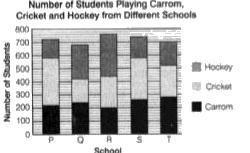The respective ratio of students studying in school P, Q and Ris 8:6:7. What would be the respective ratio of students if the ratio increases by 15%, 20% and 25% respectively?
189:140:175
149:125:165
1:2:3
184:144:175
The correct Answer is:D
To solve the problem step by step, we will first determine the initial number of students in schools P, Q, and R based on the given ratio of 8:6:7. Then we will apply the respective percentage increases to find the new number of students and finally calculate the new ratio.
Step 1: Assign values based on the ratio
The ratio of students in schools P, Q, and R is given as 8:6:7. We can assign a base value to these ratios for easier calculations. Let's assume:
- Students in school P = 8x
- Students in school Q = 6x
- Students in school R = 7x
Step 2: Calculate the increased number of students for each school
Now, we will calculate the increased number of students based on the given percentage increases.
1. For school P (15% increase):
Increase=15% of 8x=15100×8x=1.2x
New number of students in P=8x+1.2x=9.2x
2. For school Q (20% increase):
Increase=20% of 6x=20100×6x=1.2x
New number of students in Q=6x+1.2x=7.2x
3. For school R (25% increase):
Increase=25% of 7x=25100×7x=1.75x
New number of students in R=7x+1.75x=8.75x
Step 3: Write the new ratio
Now, we have the new number of students as:
- School P: 9.2x
- School Q: 7.2x
- School R: 8.75x
Thus, the new ratio of students in schools P, Q, and R is:
9.2x:7.2x:8.75x
Step 4: Simplify the ratio
To simplify the ratio, we can eliminate x from all terms:
9.2:7.2:8.75
To simplify further, we can convert these to whole numbers by multiplying each term by 100:
920:720:875
Now, we can find the greatest common divisor (GCD) to simplify the ratio further. The GCD of 920, 720, and 875 is 5. Therefore, we divide each term by 5:
9205:7205:8755=184:144:175
Final Result
The respective ratio of students studying in schools P, Q, and R after the increases is:
184 : 144 : 175
The ratio of students in schools P, Q, and R is given as 8:6:7. We can assign a base value to these ratios for easier calculations. Let's assume:
- Students in school P = 8x
- Students in school Q = 6x
- Students in school R = 7x
Now, we will calculate the increased number of students based on the given percentage increases.
Increase=15% of 8x=15100×8x=1.2x
New number of students in P=8x+1.2x=9.2x
Increase=20% of 6x=20100×6x=1.2x
New number of students in Q=6x+1.2x=7.2x
Increase=25% of 7x=25100×7x=1.75x
New number of students in R=7x+1.75x=8.75x
Now, we have the new number of students as:
- School P: 9.2x
- School Q: 7.2x
- School R: 8.75x
9.2x:7.2x:8.75x
To simplify the ratio, we can eliminate x from all terms:
9.2:7.2:8.75
920:720:875
9205:7205:8755=184:144:175
The respective ratio of students studying in schools P, Q, and R after the increases is:
184 : 144 : 175
Topper's Solved these Questions
Similar Questions
The ratio of the students in schools A, B and C is 5 : 4 : 7. If the number of students in the schools are increased by 20%, 25% and 20% respectively, what would be the new ratio of the students in schools A, B and C? 5:5:7 b. 30:25:42 c. 30:20:49 d. cannot be determined e. none of these
View SolutionWhat is the single discount equivalent to successive discounts of 15% ,20% and 25%
View Solution
Knowledge Check
In 1998, ratio of the numbers of students taking examinations in x and z states are respectively 3:5:6. Next year, the numbers of students are increased by 20%, 10% and 20% respectively. If ratio of the numbers of students in states x and z is 1 : 2, then find the number of students who sit to take examination in 1998.
A5000B6000C75000DData is insufficientIn 1998, ratio of the numbers of students taking examinations in x and z states are respectively 3:5:6. Next year, the numbers of students are increased by 20%, 10% and 20% respectively. If ratio of the numbers of students in states x and z is 1 : 2, then find the number of students who sit to take examination in 1998.
A7200B6000C7500DData inadequateIn a university the number of stu dents studying science, mathe matics and language is in the re spective ratio of 2:4:9. If the number of students of science, mathematics and language is in creased by 10%, 20% and 40% respectively, what will be the new ratio?
AA) 63:11:24BB) 12:23:63CC) 24:11:63DD) 11:24:63
The respective ratio of salaries of A and B is 8:7. if the salary of B increased by 20% and the salary of A increases by 21% , the new ratio becomes 96:77 respectively . What is A's salary ?
View SolutionSalaries of Akash, Bablu and Chintu are in the ratio of 2 : 3 : 5. If their salaries were increased by 15%, 10% and 20% respectively, then what will be the new ratio of their salaries?
View SolutionThe number of employees in companies A, B and C are in the ratio 3:2: 4 respectively. If the number of employees in the three companies is increased by 20%, 30% and 15% respectively, what will be the new ratio of employees working in companies A, B and C respectively?
View SolutionThe ratio of the speed of P, Q and R is 10:12:15 respectively. What is the ratio of the time taken by P. Q and R respectively to cover the same distance?
View SolutionStudy the following graph carefully to answer the questions.

If the number of students playing each game in school S in increased by 15% and the number of students playing each game in school Q is decreased by 5% then what will be the difference between number of students in school S and Q?
View Solution
